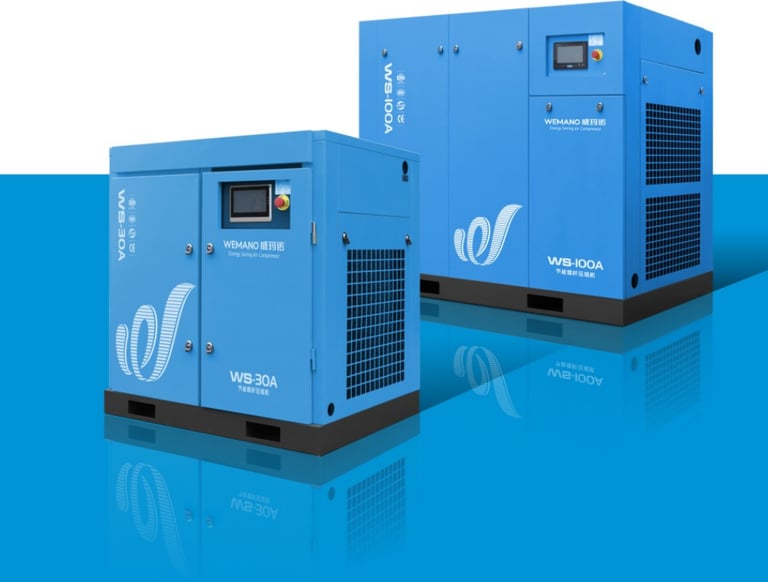"Air Compressor" what Exactly Is It?
In the vast landscape of Google SERPs, we’re sure you’ve already come across countless introductions explaining what an air compressor is. Today, however, we’re going to break down this essential tool in the simplest way possible – not only clarifying what an air compressor is at its core, but also diving into its wide range of practical applications and real-world uses.
BASIC KNOWLEDGE OF AIR COMPRESSORS
Sofiya
7/2/20253 min read


What Is an Air Compressor?
An air compressor is a device that compresses air to a higher pressure.
You can compare the working principle of an air compressor to something as simple as a bicycle pump in everyday life.
For example, when you use a pump to inflate a bicycle tire, the pump compresses the air by pushing the piston and forces the air into the tire, increasing the tire's pressure.
The principle of an air compressor is similar, but on a much larger scale—it handles large volumes of air and provides continuous high-pressure air to various industrial equipment. Air compressors converts mechanical energy into compressed air energy, widely used in various industries, and is an essential component in many industrial systems.
Definition and Working Principle of Air Compressors
How Does an Air Compressor Work?
Depending on the type of compressor, the working principle may vary, but the basic process includes intake, compression, and exhaust. During compression, the air volume decreases, and pressure increases, storing energy.
1. Intake: The air compressor draws in air through the intake valve.
2. Compression: The captured air is compressed, reducing its volume and significantly increasing air pressure.
3. Storage: The compressed air is stored in an air tank, ready for use at any time.
4. Discharge: When pneumatic tools or industrial applications require compressed air, the discharge valve opens, releasing the stored air to power various operations in the factory.
What is the most common type of air compressor?
1. Screw Air Compressors
Screw air compressors use the rotating motion of two screws to compress air.
This type of compressor is more efficient and is ideal for large-scale production and industrial applications, particularly in situations requiring continuous high-pressure air.
But what needs to be noted is,Screw air compressors can be broadly classified into two types:
What's the difference between oil-free and oil-injected screw compressors?
oil-free screw air compressors:
on the other hand, operate without any oil in the compression chamber, ensuring 100% clean and contaminant-free air. These are essential in industries like pharmaceuticals, food and beverage, and electronics where air purity is critical.
How to work: https://youtu.be/BlAtVyiGT84
oil-injected screw air compressors:
use lubricating oil to cool, seal, and lubricate internal components, making them highly efficient and ideal for general industrial applications. They offer high performance and durability for continuous operation.
How to work:https://youtu.be/ME38zPnz8w8
2.Piston Air Compressors
Piston air compressors are the most common type, often used by small to medium-sized businesses. Their working principle is similar to that of an automobile engine, where a piston moves up and down in a cylinder to compress air. The advantages of piston air compressors include simple structure and lower cost, making them suitable for general factories and smaller equipment.
https://www.nbchao.com/k/13680/
3.Centrifugal Air Compressors
Centrifugal air compressors use high-speed rotating impellers to accelerate air and generate pressure. This type of compressor is typically used in large industrial settings and can handle high volumes of air, making it ideal for applications in industries like oil and chemical processing.
Operating principle:
1.Impeller: Ambient air is drawn into the center of a high-speed rotating impeller, a wheel equipped with curved blades.
2.Centrifugal Force: As the impeller spins, centrifugal force pushes the air outward, rapidly increasing its velocity and kinetic energy.
3.Diffuser: The high-velocity air then enters the diffuser, a diverging duct that slows down the airflow. As the air slows, its kinetic energy is converted into pressure.
4.Discharge: Finally, the compressed air exits the compressor and is directed to an air receiver tank or directly into the air system.
Main Applications of Air Compressors
1.Manufacturing Industry Applications
air compressors power pneumatic tools, automation equipment, and other machinery on production lines. For example, pneumatic wrenches, spray painting equipment, and packaging systems all rely on air compressors for power.
· Pneumatic wrenches
· Painting sys tems
· Packaging machines
2.Construction Industry Applications
air compressors provide power for pneumatic tools like drills and piling machines. Efficient air compressors can speed up the construction process and enhance productivity.
· Jackhammers
· Drilling equipment
· Pile driver
3.Automotive Industry Applications
air compressors are used for tasks like spray painting, tightening wheels, and air suspension systems. Air compressors are essential in providing reliable power for these operations.
· Spray painting
· Tire inflation
· Air suspension systems
· Pneumatic tightening tools
4.Medical Industry Applications
air compressors power devices like ventilators, pneumatic tools, and central oxygen supply systems in hospitals. High-purity compressed air is vital for ensuring the proper functioning of medical equipment.
· Ventilators
· Surgical pneumatic tools
· Central air and oxygen supply systems
By the end, you’ll walk away with a clearer, more actionable understanding of air compressors – one that goes beyond surface-level definitions and helps you grasp their true value in various scenarios. Whether you’re a curious beginner or looking to refresh your knowledge, this guide is designed to make the topic accessible and insightful.
Want help choosing the best compressor? Contact us now.


